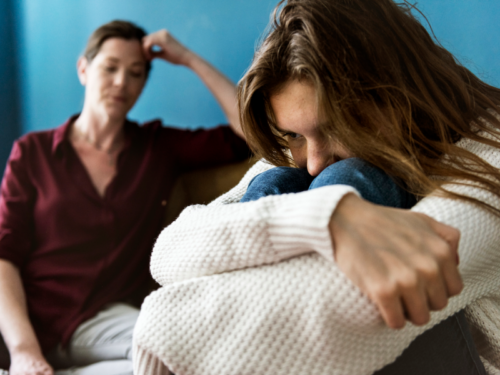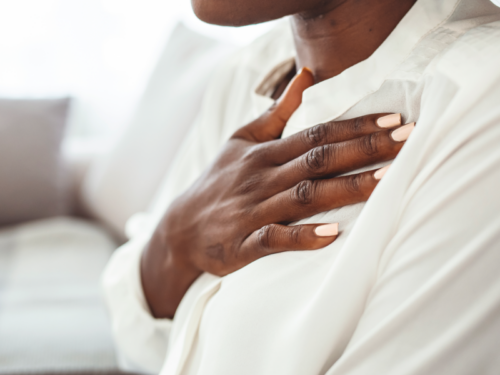
Table of Contents
What Is the Generalized Anxiety Disorder (GAD-7) Screener?

Written By: Elizabeth Kroll

Clinically Reviewed By: Dr. Don Gasparini
February 15, 2024
5 min.
You may have completed the anxiety screening tool at a recent physical exam or mental health intake appointment. Here’s how it’s used in clinical and research settings.
Learn more about our Clinical Review Process
Table of Contents
If you’ve recently attended a doctor’s appointment with your primary care physician or had a mental health intake appointment, you probably filled out a form about anxiety symptoms. Most often, this form is the Generalized Anxiety Disorder-7 (GAD-7) screener, which helps clinicians and researchers assess anxiety symptom severity. The GAD-7 is a patient health questionnaire that offers standardized mental health screening, like the Patient Health Questionnaire-9 (PHQ-9), which measures depression severity.
Continue reading to learn more about the GAD-7 and its use in research and healthcare settings—including Charlie Health’s virtual Intensive Outpatient Program (IOP).
Join the Charlie Health Library
Get mental health updates, research, insights, and resources directly to your inbox.
You can unsubscribe anytime.
What is the GAD-7 assessment tool?
The GAD-7 is a set of seven standardized questions used to assess common anxiety symptoms. It was developed in 2006 by Robert Spitzer and colleagues and originally had 13 questions. Researchers quickly realized that six of the questions did not correlate strongly enough with an anxiety disorder diagnosis, though, and dropped them, narrowing the tool down to seven questions.
While the GAD-7 is standardized to assess generalized anxiety disorder (GAD), it is also approved to screen for other anxiety disorders, such as social anxiety disorder and panic disorder, which often co-occur with generalized anxiety. All of these conditions are classified and diagnosed in the Diagnostic and Statistical Manual of Mental Disorders (DSM-5).
There are two variations of the GAD-7 used for different purposes: the GAD-7 24-h (the Generalized Anxiety Disorder 24-hour screener) and the GAD-2. As its name suggests, the former includes the same seven questions as the GAD-7 but asks clients about their symptoms over the last 24 hours instead of the last two weeks. The GAD-7 24-h would typically be used in a situation where a more immediate assessment of anxiety symptoms is needed, such as in emergency departments, acute care settings, or during crisis interventions.
GAD-7
GAD-7 24-h
GAD-2
A seven-question tool used to assess rates of anxiety over the last two weeks.
A variation of the GAD-7 that asks about anxiety symptoms over the past 24 hours.
A two-question tool used to assess anxiety.
The GAD-2, on the other hand, is a very brief anxiety screener that only includes two questions about feeling nervous, anxious, or on edge and not being able to stop or control worrying. This variation is typically used when there isn’t enough time to complete the seven-question measure. That being said, the GAD-2 has been shown to have comparable psychometric properties to the GAD-7, meaning that both reliably and accurately measure anxiety. A literature review analyzing the psychometric properties of both tools found that each identified about 80% of those with anxiety disorders.
How is the GAD-7 used for anxiety screening?
The GAD-7 is often used as a brief screening tool in primary care settings as a way for doctors to screen for anxiety without needing to refer a patient to a behavioral health specialist (which can often be hard to access). This way, a primary care physician, who often has years of built-up trust with a patient, can bring up the topic of mental health and start the conversation about mental health support. It’s also a screening tool used in various other healthcare specialties, from internal medicine to social work, where measuring anxiety may be necessary.
The GAD-7 asks people to reflect on their anxiety levels over the prior two weeks and how often they experience any of the following symptoms. Responses include "not at all," "several days," "more than half the days," or "nearly every day," each linked to a score from zero to three, respectively:
- Feeling nervous, anxious, or on edge
- Not being able to stop or control worrying
- Worrying too much about different things
- Trouble relaxing
- Being so restless that it is hard to sit still
- Becoming easily annoyed or irritable
- Feeling afraid as if something might happen
A score of less than four means a person is probably experiencing minimal anxiety. A score of five to nine indicates anxiety symptoms that are typically mild. Ten is the most common cut-off score for an anxiety diagnosis, with anything from 10 to 14 indicating moderate anxiety and 15 to 21 indicating severe anxiety. Occasionally, a cut-off score of eight will be used to screen for an anxiety diagnosis when researchers or clinicians want to increase the scale's sensitivity.

However, none of these scores are a diagnosis of anxiety or an anxiety episode. For a diagnosis, you need to reach out to a healthcare provider. Also, regardless of your anxiety severity, talking with a professional is recommended if you’re struggling with your mood, mental health, or anxiety symptoms.
How is the GAD-7 used in research?
The GAD-7 is also used in research as a way to measure change in anxiety symptoms or anxiety’s correlation to other disorders and situations. For example, a study published in November 2023 measured the effect that pain relief medication had on the anxiety symptoms of orthodontic clients. In December 2023, a study was published that showed a significant increase in anxiety symptoms, measured by the GAD-7, as vigorous physical activity decreased in a sample of Korean youth. Most recently, a brand new study published in February 2024 showed that high GAD-7 scores were associated with a higher risk of insomnia.
How does Charlie Health use the GAD-7?
Charlie Health presents the GAD-7 questions on our intake, discharge, and all post-discharge surveys. These surveys allow us to assess a client's acuity and well-being at intake and track how their symptoms may change through treatment and after they’ve discharged. Whenever you see data or graphics that cite anxiety symptom improvement within our program, those calculations are based on GAD-7 scores. Some of our findings based on GAD-7 scores are as follows:
- After discharging from Charlie Health’s virtual IOP, clients’ GAD-7 anxiety scores decreased by 47% on average, with many clients moving below the clinical cutoff for generalized anxiety disorder.
- This decrease was also maintained at three and six months post-discharge.
- In a comparison of year-over-year data, we found that clients’ anxiety scores improved by nearly 13% this year compared to those discharged last year.
- Clients with anxiety reported a simultaneous reduction in symptoms and an improvement in physical health symptoms after receiving holistic care at Charlie Health.
Charlie Health also uses GAD-7 data to assess program quality and improve our industry-leading care by digging into interesting findings within our data. Our most recent publication used the GAD-7 to assess anxiety symptoms at intake and how it, along with other symptoms, correlated with treatment engagement.

Anxiety treatment at Charlie Health
If you or a loved one are struggling with anxiety, Charlie Health is here to help. Charlie Health’s virtual Intensive Outpatient Program (IOP) provides more than once-weekly mental health treatment for young people dealing with complex mental health conditions, including panic disorder, social anxiety disorder, or other anxiety-related mental disorders. Our expert clinicians incorporate evidence-based therapies into individual counseling, family therapy, and group sessions. With treatment, managing your anxiety severity is possible. Fill out the form below or give us a call to start healing today.
References
https://pubmed.ncbi.nlm.nih.gov/16717171/
https://www.sciencedirect.com/science/article/abs/pii/S088761851400084X
https://www.ncbi.nlm.nih.gov/pmc/articles/PMC3448706/
https://helvia.uco.es/bitstream/handle/10396/14896/moriana.pdf?sequence=1&isAllowed=y
https://formative.jmir.org/2023/1/e47895
https://journals.sagepub.com/doi/pdf/10.1177/20552076231225572





